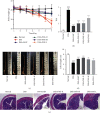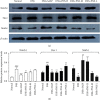Painong San, a Traditional Chinese Compound Herbal Medicine, Restores Colon Barrier Function on DSS-Induced Colitis in Mice
- PMID: 34966434
- PMCID: PMC8712168
- DOI: 10.1155/2021/2810915
Painong San, a Traditional Chinese Compound Herbal Medicine, Restores Colon Barrier Function on DSS-Induced Colitis in Mice
Abstract
Objective: The intestinal barrier decreases in colitis and restores the integrity of the mucosal barriers that could be used for the treatment of colitis. Painong San (PNS), a traditional Chinese compound herbal medicine originally recorded in "Jingui Yaolve" by Zhongjing Zhang in the Later Han Dynasty, is often used in China and Japan to treat various purulent diseases including intestinal carbuncle. This study was to investigate the effect of PNS on mucosal barrier function in mice with DSS-induced colitis and its related mechanisms.
Methods: BALB/C mice were given 3% DSS to induce colitis. The body weight and stool status of the mice were recorded daily, and the histopathological changes of the colon were observed after execution. The permeability of the intestinal mucosa was measured by fluorescein isothiocyanate-dextran 4000, the change of intestinal microbiota was measured by 16S rDNA, and the tight junction-related proteins and Muc-2 were investigated by immunohistochemical or immunofluorescence. The possible signaling pathways were detected by western blot.
Results: Compared with the control group, the composition of the microbiota in the PNS group was close to that of the normal group, the number of goblet cells was improved, and the mucosal permeability was significantly reduced. PNS could upregulate the expression of tight junction-related proteins (ZO-1, claudin-1, and occludin) and Muc-2, and at the same time, regulate the Notch pathway.
Conclusion: PNS could effectively improve the mucosal barrier function through multiple ways, including restoring the balance of intestine flora, enhancement of the mucous layer barrier, and mechanical barrier function. These protective effects may relate to inhibiting the Notch signaling pathway activated by DSS.
Copyright © 2021 Xuelin Rui et al.
Conflict of interest statement
The authors declare that they have no conflicts of interest.
Figures






Similar articles
-
Painong-San extract alleviates dextran sulfate sodium-induced colitis in mice by modulating gut microbiota, restoring intestinal barrier function and attenuating TLR4/NF-κB signaling cascades.J Pharm Biomed Anal. 2022 Feb 5;209:114529. doi: 10.1016/j.jpba.2021.114529. Epub 2021 Dec 10. J Pharm Biomed Anal. 2022. PMID: 34915325
-
Enhanced therapeutic effect on colitis with powder formulations of Painong San associated with the promotion of intestinal adhesion and absorption.J Ethnopharmacol. 2022 May 10;289:115030. doi: 10.1016/j.jep.2022.115030. Epub 2022 Jan 29. J Ethnopharmacol. 2022. PMID: 35093456
-
2,3,5,4'-Tetrahydroxystilbene-2-O-β-D-glucoside, a major bioactive component from Polygoni multiflori Radix (Heshouwu) suppresses DSS induced acute colitis in BALb/c mice by modulating gut microbiota.Biomed Pharmacother. 2021 May;137:111420. doi: 10.1016/j.biopha.2021.111420. Epub 2021 Feb 23. Biomed Pharmacother. 2021. PMID: 33761623
-
Effect of toll-like receptor 3 agonist poly I:C on intestinal mucosa and epithelial barrier function in mouse models of acute colitis.World J Gastroenterol. 2017 Feb 14;23(6):999-1009. doi: 10.3748/wjg.v23.i6.999. World J Gastroenterol. 2017. PMID: 28246473 Free PMC article.
-
Critical Signaling Transduction Pathways and Intestinal Barrier: Implications for Pathophysiology and Therapeutics.Pharmaceuticals (Basel). 2023 Aug 29;16(9):1216. doi: 10.3390/ph16091216. Pharmaceuticals (Basel). 2023. PMID: 37765024 Free PMC article. Review.
Cited by
-
Sijunzi decoction alleviates inflammation and intestinal epithelial barrier damage and modulates the gut microbiota in ulcerative colitis mice.Front Pharmacol. 2024 Apr 8;15:1360972. doi: 10.3389/fphar.2024.1360972. eCollection 2024. Front Pharmacol. 2024. PMID: 38650625 Free PMC article.
References
-
- Sánchez de Medina F., Romero-Calvo I., Mascaraque C., Martínez-Augustin O. Intestinal inflammation and mucosal barrier function. Inflammatory Bowel Diseases . 2014;20(12):2394–2404. - PubMed
LinkOut - more resources
Full Text Sources
Miscellaneous

